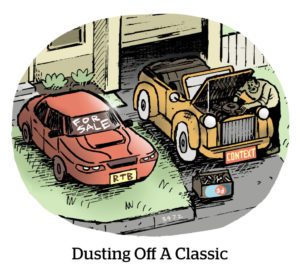 GumGum, the image recognition tech startup, announced two C-level appointments on Monday as the company sharpens its focus on contextual advertising technology.
GumGum, the image recognition tech startup, announced two C-level appointments on Monday as the company sharpens its focus on contextual advertising technology.
Patrick Gildea, the former CFO of Gracenote, has joined GumGum as financial chief, and Ben Plomion was promoted to chief growth officer.
Ad tech companies have seized on contextual targeting largely because audience targeting has become more difficult in Europe thanks to GDPR, and potentially in the U.S. with the advent of CCPA next year, as well as in mobile environments like Apple’s iOS and Safari browser, which are now equipped with Intelligent Tracking Prevention software that blocks most user-level tracking.
“With advertisers right now the urgency is in finding targetable environments to bring their message,” said GumGum CEO Phil Schraeder. “Given challenges in other forms of targeting, we believe that’s ultimately where you’ll see advertisers and publishers working to identify opportunities.”
Vendors gear up for contextual targeting
GumGum isn’t the only company honing in on contextual ad tech, a vendor category with few independent options since Oracle acquired Grapeshot last year.
The contextual tech business Peer39, a former Sizmek subsidiary, was relaunched as an independent company last week. And last month, the video ad tech company Zefr sold its copyright management and creator platform to Vobile so it could refocus exclusively on contextual technology.
There hasn’t been strong innovation in the category, Schraeder said, since larger companies like Sizmek and Oracle hoovered up the point solutions.
Companies like Integral Ad Science, DoubleVerify and Moat (the Oracle Data Cloud unit that absorbed Grapeshot) have bundled “context” into their brand safety and viewability packages, he said.
GumGum has its roots in content recognition tech, as a network that served ads within images already displayed on a site or app. Schraeder said this native understanding of what’s on the page, not just bidstream data and ad tech metadata, will help the company carve out a more defined niche for contextual advertising.
GumGum’s sell-side challenges
But GumGum will need stronger relationships with publishers than as an ad network and demand partners for its contextual offering to take off.
“We started on the demand side,” Schraeder said. “Now we’re taking that and saying, ‘how do we bring this to both sides of the equation?’”
Bustle, a digital publisher that operates media brands like Mic, Inverse and The Outline, started working with GumGum in the past one to two years because of the image recognition capabilities, said Kai Hsing, EVP of marketing and operations.
Ironically, Hsing said Bustle doesn’t actually use GumGum’s in-image ad tech, which matches advertisers with images on the page. Bustle uses GumGum’s demand-side network – essentially leveraging the startup’s ad sales team so it doesn’t need to put boots on the ground – and its text-based contextual targeting.
“We don’t have the (image recognition tech) on, but if and when we did GumGum would be our choice,” Hsing said.
Bustle has considered adding in-image ad placements, he said, but the company uses graphics as affiliate links (so in a story about the best coffeemakers, the images are what send traffic to Amazon or other ecommerce product pages), and doesn’t want to interfere with that revenue stream.
Search-based publishers need more from contextual ad tech, said Scott Messer, media SVP at Leaf Group, a digital publisher with properties like Livestrong.com, eHow and Well+Good.
Search traffic is constantly changing based on context, he said. A Google search for “Chinese broccoli” used to return nutrition links, he said. Now it’s recipes.
“We need to understand how those things change and how we need to reclassify our own pages from, say, nutrition-based to recipes,” he said. GumGum’s image recognition helps the Leaf Group manage those taxonomies for its sites.
Most contextual advertising is based exclusively on text, Messer said, like identifying keywords on a page in order to serve or block certain ads. “And when you have thousands or even millions of articles you need a machine that can understand the content of those pages.”














